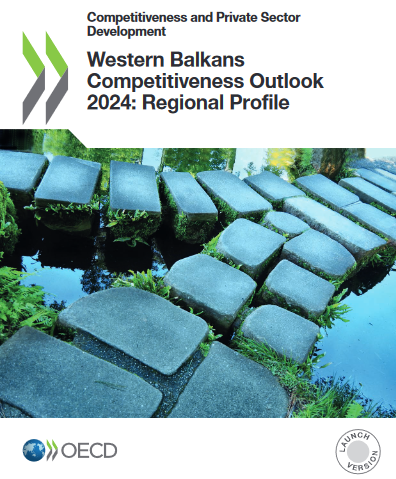Effective Policy Reforms for Research & Innovation in the Western Balkans

In recent years, the Western Balkans region has made notable advances in strengthening its science, technology, and innovation capabilities. However, the region still faces significant challenges that must be addressed to unlock its transformative potential fully.
The OECD’s Western Balkans Competitiveness Outlook 2024: Regional Profile report presents an assessment across five policy clusters crucial to accelerating the socio-economic convergence of the region, including science, technology and innovation (STI) policies in each WB economy.
The research systems in the Western Balkans are highly fragmented, with many small, underfunded public research institutes and universities. This fragmentation hinders the efficient allocation of resources and the development of critical mass in key research areas.
Low Investments Equal Low Productivity in Research
While several Western Balkans economies have significantly increased spending on scientific research in recent years, overall investments in the sector remain negligible and show little evidence of converging towards EU levels.
The region's R&D expenditure as a percentage of GDP ranges from just 0.2% in Kosovo* to 0.9% in Serbia, well below the OECD average of around 2.4%. This underinvestment is particularly evident in the business enterprise sector, where R&D accounts for less than 0.5% of GDP in most economies.
This lack of funding severely impacts the research and innovation capacity of the Western Balkans. The productivity and innovation capacity of scientific researchers remains low, with the sector failing to attract new talent.
The number of researchers in the Western Balkans has remained largely unchanged in recent years, despite significant efforts to boost STI performance across the region. Proportionally, the number of researchers is the highest in Serbia (at more than 2,218 researchers per million inhabitants), falling to a low in Bosnia and Herzegovina of 447 researchers per million.
Even given this variation, all Western Balkan economies are far below the EU average of 4,450 researchers per million inhabitants.
In addition, human resource capacity for research in some economies is dramatically affected by brain drain, particularly in important fields such as medicine, health and ICT. Furthermore, the research population is ageing, with a lack of young researchers entering the field to replace the retiring generation.
Weak Academia-Industry Linkages
Co-creation between R&D institutes and industry remains the weakest link across the region's STI systems, with incentives for business-academia collaboration either non-existent or applied inconsistently. The limited collaboration between academia and industry has hampered the commercialization of research, preventing the region from fully capitalizing on its scientific and technological capabilities.
The scale and scope of financial incentives vary greatly - from large-scale innovation vouchers and competitive grants in Serbia to ongoing preparation of collaboration grant schemes in North Macedonia, to more limited support in Montenegro, Albania, Bosnia and Herzegovina, and Kosovo*.
The commercialization of research remains limited, with receipts for the foreign use of domestic IP remaining negligible and largely stagnant at less than 0.1% of GDP.
Innovative activity in the private sector of the Western Balkans is relatively low, with few firms introducing new products or services. Small and medium-sized enterprises (SMEs) in particular lack the resources and capabilities to engage in innovation, limiting the region's ability to translate its scientific and technological knowledge into commercial success.
Participation in EU framework programmes
While there is some regional collaboration under Horizon Europe activities, particularly between Montenegro and Serbia, there is little evidence of a strategic effort to leverage regional partnerships to participate in such EU framework programmes.
Participation in projects and landmarks of the European Strategy Forum on Research Infrastructure (ESFRI) is equally driven by individual economies, with the Western Balkan economies only participating in six activities according to the 2021 ESFRI roadmap, and just half of those including participation by more than one economy.
There is also little focus on enhancing the intra-regional exchange and mobility of researchers, which could play an important role in increasing R&I capacities, leveraging existing expertise, and contributing to the development of a regional R&D ecosystem in the long term.
The Potential of Smart Specialisation in the Western Balkans
Scientific research is a key element of smart specialisation, which has gained momentum across the Western Balkans in recent years. All Western Balkans economies have embarked on the process of developing smart specialisation strategies (S3).
The state of progress varies across the region:
- In Montenegro and Serbia, S3 have been in place since 2019 and 2020 respectively, and implementation is well underway.
- North Macedonia adopted its S3 in late 2023.
- In Albania, Bosnia and Herzegovina, and Kosovo*, the development of an S3 is still in progress.
Across the existing or draft strategies, ICT and energy efficiency have been identified as priority areas, addressing key aspects of the region's green and digital transitions.
However, the incorporation of human capital development and working with education providers to upskill or reskill local workforces in support of S3 priority objectives remains somewhat overlooked.
While creating entrepreneurial and innovation skills, local capacity to support the green and digital transformations are reflected in all existing S3. However, there is no evidence of a systematic approach to reforming vocational or higher education systems to fully align with S3 proclaimed objectives.
To fully unleash the potential of S3, the WB economies will need to place a stronger emphasis on developing the necessary human capital and skills to support their S3 priorities and drive innovation-led economic development.
Underused Research Infrastructures
In contrast, research infrastructure across the region suffers from chronic underinvestment. Scientific research is predominantly publicly funded and implemented by higher education institutes (HEIs), but public sector funds are mainly allocated for teaching purposes, often neglecting research facility investments.
All economies have adopted an R&I infrastructure roadmap with support from the Regional Cooperation Council (RCC) in recent years to identify shortcomings and prioritize investments. The RCC's 2022 regional Western Balkan R&I infrastructure roadmap emphasizes the lack of funding for scientific research and concludes that R&I infrastructure in the region is currently insufficiently competitive to integrate into pan-European networks.
Several WB economies are focusing on bricks and mortar investments, particularly science and technology parks (STPs), but progress remains uneven.
For instance, Serbia's network of STPs is reaching full capacity and expanding with support from the EBRD. Montenegro officially announced the opening of its first STP in Podgorica in June 2024.
Plans to establish STPs in North Macedonia and parts of Bosnia and Herzegovina be fully finalised. Technology transfer facilities, which support the adoption of innovative business practices, remain limited and are only available at scale in North Macedonia and Serbia.
Fostering Innovation Ecosystem in the Western Balkans
Most Western Balkans economies have made significant progress in establishing a supportive infrastructure for innovation and startups, offering incubation services, business training, and networking opportunities across the region.
Some economies have also introduced dedicated financial schemes to foster innovative business activities, such as the Serbian Innovation Fund and North Macedonia's Fund for Innovation and Technological Development (FITD). More recently, Montenegro has launched the Innovation Fund of Montenegro.
However, support often targets early-stage companies more broadly rather than specific innovation activities.
Emerging Regional R&D Initiatives
Despite the strong international focus, some regional R&D initiatives have emerged. In 2017, the WB economies, alongside Bulgaria and Slovenia, established the Southeast European International Institute for Sustainable Technologies (SEEIIST) to set up a regional centre of excellence for cancer therapy and biomedical research. However, as of the end of 2023, the institute is yet to become a fully operational research centre, with activities being coordinated out of Switzerland.
In 2020, NanoALB was established to coordinate activities in the area of nanoscience and nanotechnology across Albania, Kosovo*, North Macedonia and Montenegro.
These initiatives constitute important milestones in the region's pathway to creating a regional R&I infrastructure. However, without a strong commitment from all stakeholders, manifested in mobilising adequate financial and human resources, these initiatives will likely not develop into competitive WB flagship R&I infrastructures that can integrate into global networks.
Recommendations
Despite many challenges, the Western Balkans region has significant potential to unlock its transformation potential. Key areas for improvement include:
1. Increasing R&D investment, especially in the business sector, to drive innovation and competitiveness.
2. Strengthening collaboration between academia and industry to facilitate the commercialization of research and foster knowledge transfer.
3. Retaining and attracting talented researchers through improved working conditions, career development opportunities, and international collaboration.
4. Fostering a more innovative business environment, particularly for SMEs, by providing access to financing, technical assistance, and support for entrepreneurship and technology adoption.
One of the recommendations for strengthening regional infrastructure connectivity includes introducing support mechanisms to encourage targeted R&D and innovation at the regional level.
Finally, the report suggests stimulating competition for regional research excellence by introducing joint scientific research grant programmes for selected priority sectors.
More specifically, by leveraging existing research and innovation infrastructures and investment into strategically important sectors.
